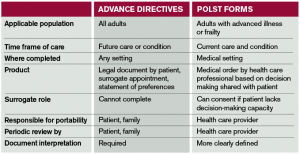A patient’s POLST form should be readily accessible by caregivers and EMS to facilitate its implementation. The form should accompany the patient on transfer. In states with POLST programs, most hospitals honor the POLST form that accompanies a patient until the patient is reassessed. In an emergency where the attending physician is precluded from discussion with the patient, the orders expressed on the POLST form should be followed. Challenges include when the POLST form is unavailable, incomplete, unsigned, or with a seeming inherent contradiction (eg, DNR/full treatment, attempt cardiopulmonary resuscitation, and comfort measures only).5,6
Explore This Issue
ACEP Now: Vol 33 – No 08 – August 2014How Does a POLST Form Differ From an Advance Directive?
The POLST form complements an advance directive (see Table 1). It is not necessarily a request to withhold resuscitation. In the prehospital setting, POLST expands out-of-hospital DNR orders, which only apply when the patient is in cardiopulmonary arrest.
Case 1: A 55-year-old male with aggressive lymphoma responding well to treatment is visiting from out of state. He presents to the ED with cough, fever, rigors, and dyspnea. He develops hypotension, hypoxemia, and increased respiratory distress but retains decision-making capacity. He brings his POLST form completed in his home state that states, “Do Not Attempt Resuscitation and Limited Additional Interventions (which excludes mechanical ventilation).” You discuss with him whether he would reconsider and be intubated. He consents to intubation, and you proceed accordingly.
The patient with decision-making capacity has authority to override a prior POLST order. It is essential whenever possible to pause and review with the patient or surrogate to assess if they want to change their request from what is on the POLST form. This patient’s expressed decision (or, in another case, confirmation) makes moot the question of whether the form is valid outside the jurisdiction in which it was created.
Case 2: An 82-year-old female with a history of congestive heart failure presents with new onset confusion and a headache. CT shows a large intracerebral hemorrhage, which causes her to lose her decision-making capacity and from which she is not expected to recover. She is accompanied by her health care surrogate and a POLST form that indicates the patient wants CPR. The surrogate points to a notation that the form was completed when the patient had hoped to attend her great-granddaughter’s wedding, which has now already occurred. The POLST form is revised to reflect the new health condition and advise DNR, comfort measures only, and she receives palliative care.
Pages: 1 2 3 | Single Page






No Responses to “Physician Orders for Life-Sustaining Treatment Forms: What You Need to Know”